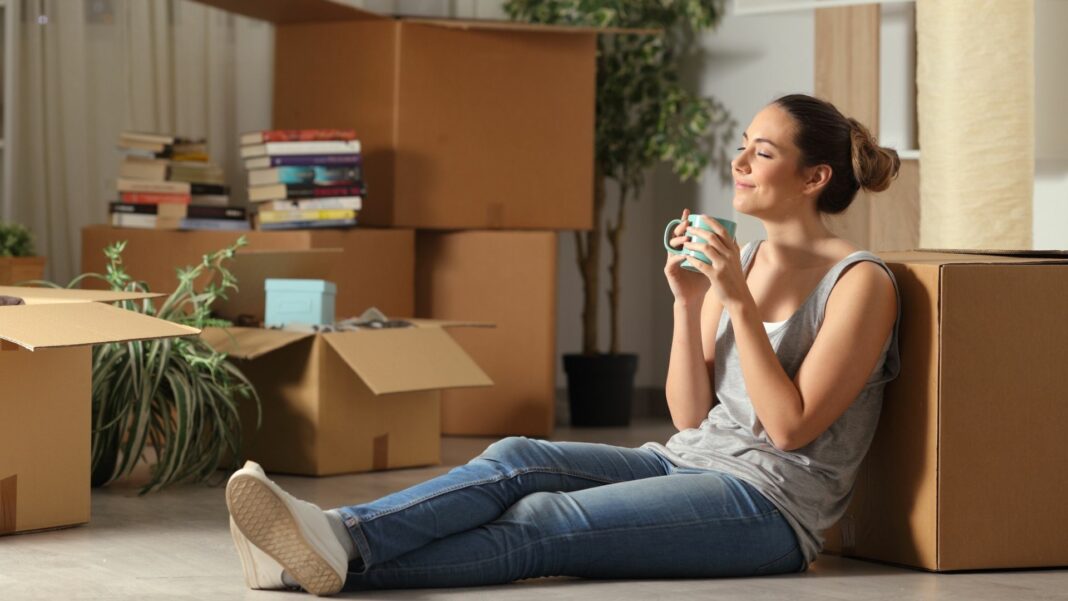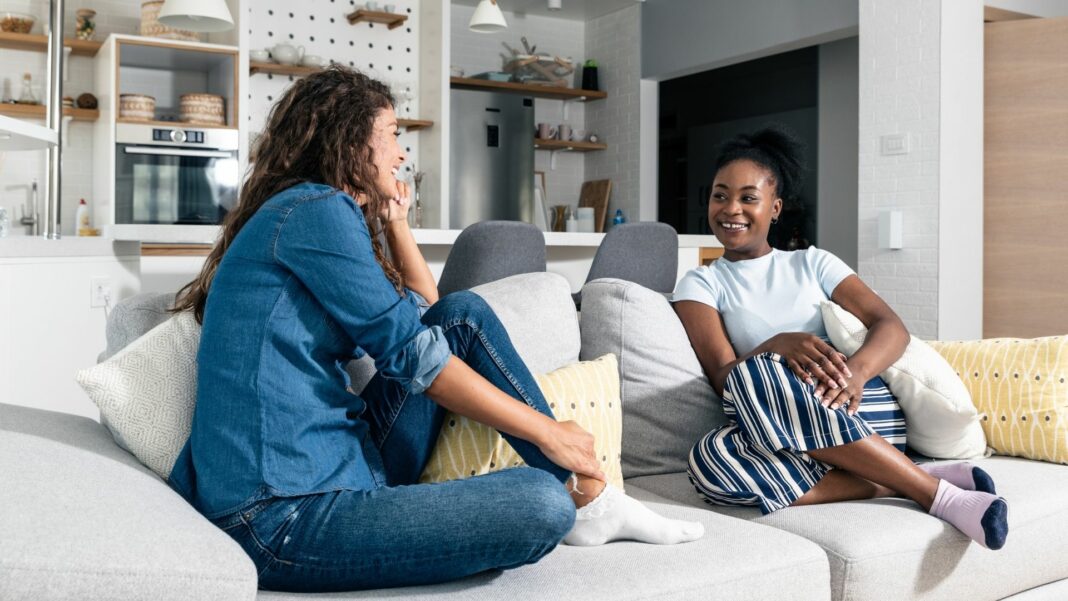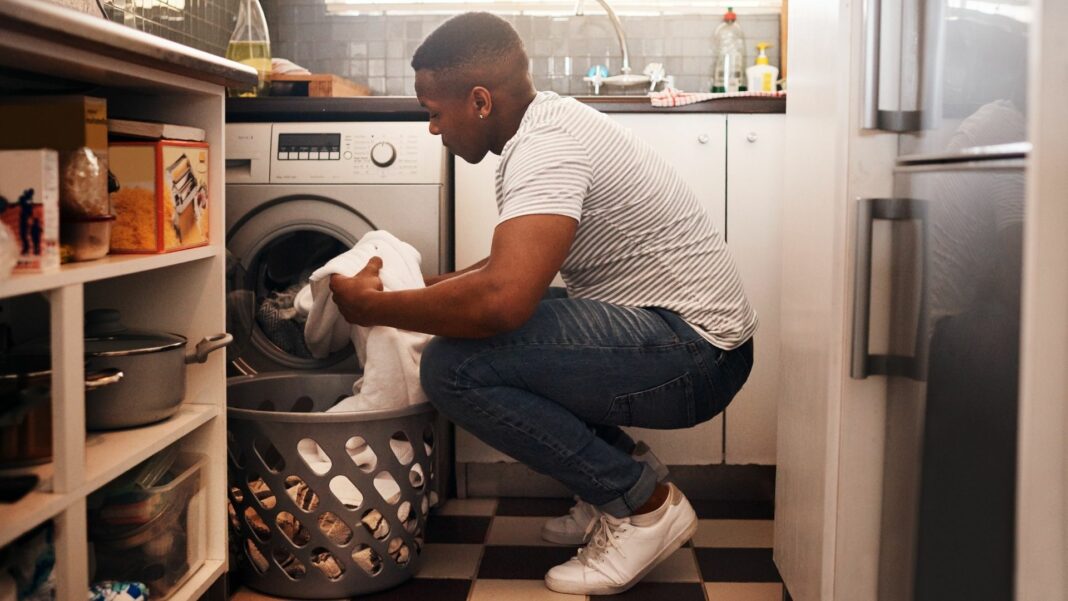Whether you’re moving out of your parent’s house or making the jump from the college dorm room into your own place, renting your first apartment is an occasion you’ll remember for the rest of your life. Taking this big step could be your first move into adulthood.
New apartment shopping, going through the application process, and budgeting for expenses may be tricky, but your hard work will pay off in the end. To make this transition as smooth as possible, you’ll need a bit of guidance. We’ve put together a moving-into-your-first-apartment checklist with helpful tips for first-time renters. So read on to find out everything you need to know before signing a lease, from financial strategies to moving out essentials.

Your first apartment checklist
- Identify your budget
- Choose your neighborhood
- Consider a roommate
- Plan your timeline
- Think about amenities
- Ask questions
- Plan expenses
- Complete the paperwork
- Gather the essentials
- Plan your move
- Clean your space
1. Identify your budget
The U.S. Department of Housing and Urban Development recommends that you spend no more than 30% of your gross monthly income on rent. Also, you will need to pay first and last month’s rent, plus put down a security deposit before you can move into your first apartment. Make sure you can afford the upfront payments and monthly rent before filling out your first apartment essentials list. You want to enjoy life while leasing instead of scrounging every month.
Look around at different locations and see how the rent differs from city to city. Cities with higher average rents may have you looking for a roommate.
2. Choose your neighborhood

Once you have a set budget, it’s time to start looking for apartments in the best neighborhoods. Do you want to live in a downtown metropolis where all the action is or in a quiet suburban area near family-friendly parks and outdoor spaces? Do your research early to find which area in your city will fit your needs. Some things to consider include your commute time to work and other points of interest, proximity to shopping and retail stores, and the walkability of the area.
3. Decide if you need a roommate

If your rent is looking like it’s going to wind up costing you an arm and a leg, it’s time to start looking into getting a roommate to split the bill. But before you hop online and start the hunt for a roommate, you should take the time to reflect on what exactly you’re looking for when it comes to a housemate.
Take the time to weigh both the pros and cons of having a roommate. If you decide in favor of it, it’s time to begin the hunt. This won’t be the easiest task, as you have to make sure that you’re compatible when it comes to cleanliness, pet preference, and schedules, as well as share the same ideas about having people over. These are all things to consider when entering into a roommate agreement. If you like to keep to yourself, look for a roommate who does, too. If you’re looking for a lifelong friend, be upfront when searching for a roommate so everyone is on the same page.
4. Plan your timeline
Next up on the first apartment checklist is timing. Rent prices are subject to change based on the seasons, so you can save on rent by being strategic during your search. For example, in San Francisco, renting an apartment during the winter will help you score some great deals as that is generally when prices are the lowest. This is a trend in other cities, too, since winter is generally when landlords and property owners find it the hardest to fill their vacancies. Less competition means lower prices for you.
It’s crucial that you know the best time to start looking for an apartment. If you don’t have much time to move, there’s always the option of finding a place to sublet or renting an apartment on a month-to-month basis before moving into your dream apartment. You should also keep in mind that if you’re renting with a pet it’s likely to add a little time to your search, as pet-friendly apartments are a bit harder to come by in many cities.
5. Consider amenities

When choosing your first apartment, you’ll want to think about the amenities. Apartment complexes will offer varying amenities that could impact the monthly rent of your unit. Many renters look for a fitness center, in-unit washer and dryer, dishwasher, pool, outdoor space, and covered parking. Factor these amenities into your budget and narrow your apartment search to include which top amenities matter to you most.
6. Ask questions during your tours
Before you finally pull the trigger on signing a lease, you need to ask as many questions as you can concerning the rental. For example, you should ask about the noise levels in the apartment, which utilities you’ll be responsible for, and what the landlord expects of you as a renter.
This is one part of the first apartment checklist that will depend on the apartment you’re interested in. Ask specific questions based on the apartment, location, and neighborhood you’re considering. Handle this step as you tour the apartment with the owner, landlord, or property management company. Bring along a checklist of questions to ask and a pen and paper to take any notes.
7. Plan for future expenses
The first month of renting an apartment will come with its own set of large expenses, usually including a security deposit, applicable pet deposit, and any application fees. All of these expenses should be discussed before you sign the lease. The security deposit should be reimbursed at the end of your lease, but make sure to read the fine print and follow the rules so you can get your money back.
Upfront expenses are only the first part of total costs. Other things, like utilities, parking, internet, and your renters insurance policy usually come with monthly payments. While some apartments include utilities and parking in the monthly rent, it’s important to make sure which additional fees you are expected to pay.
8. Complete the paperwork
Most property owners and landlords will require a fair amount of “paperwork” for your rental application, including documentation of your rental history, proof of monthly income, your credit score for credit checks, and any past rental or personal references. Getting these items together can take some time, so once you start your apartment search you’ll want to gather your paperwork ahead of time, too.
9. Gather the essentials you’ll need for you first apartment
When renting your first apartment, one of the most important things you’ll need to do is to furnish it. Unless you’re renting a furnished apartment, you’ll likely be starting from scratch. Create a checklist of the stuff you need for your first apartment. You can shop for these essentials ahead of time and budget for the basics. Here is a sample move-in list for most new apartments. Gather these items and get ready to move in. Let’s start with the living room checklist for an apartment. After that, we have the bedroom furniture list for your new apartment. Then we’ll move on to the bathroom, kitchen, dining room, and other areas of your new home.
Living room:
- Sofa
- Coffee table
- End tables
- TV and console table
- Curtains
- Rug
- Lamps
- Decor
Bedroom:
- Bed frame, box spring, and mattress
- Pillows, sheets, and blankets
- Nightstand
- Curtains
- Dresser
- Hangers
- Laundry hamper
- Shoe rack
- Mirror
Bathroom:
- Toiletries
- Toiletpaper
- Towels
- Hand soap and dispenser
- Bathmat
- Shower curtain
- Shower caddy
- Trash bin
- Plunger
- Toilet brush
Kitchen and dining room:
- Kitchen/dining table and chairs
- Pots and pans
- Dishware
- Drinking glasses
- Coffee mugs
- Coffee maker
- Utensils
- Oven mitts
- Dishrags
- Dish soap and sponges
- Baking trays
- Measuring cups
- Tupperware
- Dish drying rack
- Paper towels
- Paper towel holder
- Aluminum foil and saran wrap
- Trash bin and trash bags
- Miscellaneous appliances (blender, slow cooker, mixer)
Miscellaneous household items:
- Vacuum
- Broom and dustpan
- Mop and bucket
- Household cleaners (glass cleaner, wood cleaner, floor cleaner)
- Extension cords
- Iron and ironing board
- Wi-Fi router
- Desk and desk chair
- Air mattress for guests
10. Plan your move

Now that your lease is signed and you’ve shopped for your new apartment, it’s time to plan your move. Decide if you are going to rent a moving truck or hire movers. If you have a team of helpers, make sure they have all of the information for getting to your new apartment. Consider renting equipment that will make moving furniture easier like a dolly, and moving blankets to cover any wood furniture.
While hiring movers can be more expensive than moving yourself, it’s less physical strain and and a quicker process. If your budget allows, professional movers can optimize your move. Organize your move by going through your personal items and donating or selling any unwanted furniture or clothes. Use this as an opportunity for a fresh start. Make sure to label all of your boxes to make unpacking your space simple and effective.
11. Clean your new apartment before moving in
Once you’ve found your perfect place, it’s time to move in. Before move-in day, make sure you’ve done a full inspection of the apartment and spoken to your landlord or property manager about any pre-existing damages, marks on walls, or broken appliances. Take advantage of the empty apartment to complete a full pre move cleaning of your space. Once you’ve cleaned out any remnants of the prior tenant, you’ll be able to begin your fresh start.
To make your experience renting your first apartment even easier, we’ve created a checklist for you to follow as you search, apply, and move into your first apartment.
Frequently asked questions for first time apartment renters
Typically, property managers will ask for your rental history, proof of monthly income, references, and your social security information to run a credit or background check. If you need to know which documents you need to provide, give the owner or leasing agent a call to find out what they require.
Rental scams are listings that try to take advantage of prospective renters. When searching for your first apartment, it’s imperative that you make sure you are searching for verified listings. Don’t ever provide your personal information such as your social security number or bank account number without touring the unit and verifying that the landlord or property management company is legitimate. For more information on rental scams check out our guide on common rental scams and how to avoid them.
he answer to this question will depend on your apartment complex and property owners. Tenants may be responsible for some utilities such as internet and electricity, but property owners may include gas and water in your monthly rent amount. Include this question on your list when touring potential units. There are both pros and cons to having utilities included, such as not having access to the thermostat.
The best rule for determining how much you can afford on rent is the 30% rule, which states that a renter should spend no more than 30% of monthly income on the cost of rent. To help you identify how much rent you can afford, it’s best to use a rent calculator so that you can have an accurate idea of what price range you are working with.
Moving out can be just as exciting as moving in, and as challenging. Moving out essentials include a few to-do items, like giving your landlord proper notice as defined in your lease agreement. If you paid first and last month’s rent, plus a security deposit, discuss those figures before turning over the keys. Cancel your utilities and renters insurance policies, and forward your mail to your new home. You should make sure you leave the apartment squeaky clean and ensure it’s in tip-top condition.
Renting your first apartment is a big step, but this first apartment checklist should help. Ready to begin your search? Check out thousands of apartments for rent on Zumper and find the right one for you.



